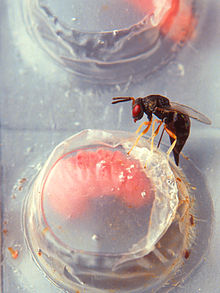| Pteromalidae Temporal range:
| |
|---|---|

| |
| Catolaccus grandis | |
| Scientific classification | |
| Domain: | Eukaryota |
| Kingdom: | Animalia |
| Phylum: | Arthropoda |
| Class: | Insecta |
| Order: | Hymenoptera |
| Superfamily: | Chalcidoidea |
| Family: | Pteromalidae Dalman, 1820 |
| Subfamilies | |
|
Many (see text) | |
The Pteromalidae are a large family of wasps, the majority being parasitoids of other insects. They are found throughout the world in virtually all habitats, and many are important as biological control agents. The oldest known fossil is known from the Early Cretaceous.[1]
Prior to 2022, the subfamily-level divisions of the family were highly contentious and unstable, and the family was thought to be "artificial", composed of numerous, distantly related groups (polyphyletic). In essence, a "pteromalid" was any member of the Chalcidoidea that had five-segmented tarsi and did not have the defining features of any of the remaining families with five-segmented tarsi.
In 2022, the Pteromalidae was split into 24 families.[2]
- ^ Barling, Nathan; Heads, Sam W.; Martill, David M. (October 2013). "A new parasitoid wasp (Hymenoptera: Chalcidoidea) from the Lower Cretaceous Crato Formation of Brazil: The first Mesozoic Pteromalidae". Cretaceous Research. 45: 258–264. Bibcode:2013CrRes..45..258B. doi:10.1016/j.cretres.2013.05.001. ISSN 0195-6671.
- ^ Roger A. Burks; Mircea-Dan Mitroiu; Lucian Fusu; et al. (20 December 2022). "From hell's heart I stab at thee! A determined approach towards a monophyletic Pteromalidae and reclassification of Chalcidoidea (Hymenoptera)". Journal of Hymenoptera Research. 94: 13–88. doi:10.3897/JHR.94.94263. ISSN 1070-9428. Wikidata Q115923766.